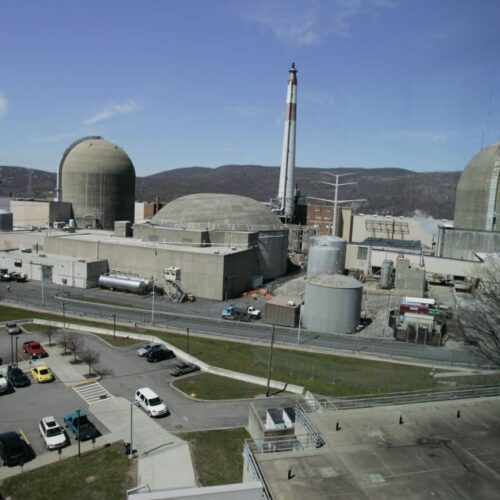Introduction
At the Indian Point nuclear power plant just north of New York City, anxieties often center on the potential consequences of a radiation release so close to so many people. More than 17 million, five percent of the U.S. population, live within 50 miles of the two reactors, which could make evacuation problematic.
Risks cited in recent weeks are drawn from the headlines. The plant sits astride two active seismic zones for which it wasn’t designed, and the probability of earthquakes was recently revised upward.
So close to Manhattan, people also worry about a terrorist attack. There is some evidence that the 9/11 hijackers considered Indian Point as a target. Over the years, the plant has been the scene of oil spills, radiation leaks and multiple protests. New York Gov. Andrew Cuomo wants it shut down.
But there’s another, lesser-known if more likely threat.
Two interstate natural gas lines, each a half-century old, run about 200 yards from a reactor containment building. They are part of a system that transports some 2.4 billion cubic feet of gas at high pressure every day. A rupture in one of those lines could create what one nuclear industry veteran familiar with the plant’s operations called “an 800-foot blowtorch.” He said the inferno could render the control room uninhabitable and make it impossible to shut down Unit 3 — assuming operators survived the fire or, worse, an explosion. (The source requested anonymity for fear of the effects on his career.)
Indian Point, alongside the Hudson River, was chosen as a reactor site in 1955, when commercial nuclear power was in its infancy.. Some risks were weighed when the plant design was undergoing its initial safety review. For instance, the impact on fish in the river was a big consideration.
In 1973, the U.S. Atomic Energy Commission, predecessor to the Nuclear Regulatory Commission, examined water-borne hazards and noted that the plant operator, Consolidated Edison at the time,“has indicated that no river traffic shipment of toxic materials or explosives currently pass the site.”
Also identified at the time, documents show: the risk posed by the two gas lines, briefly mentioned — and dismissed. “Failures of these gas lines will not impair the safe operation” of the reactor, the atomic commission concluded.
The gas lines, one 30 inches in diameter and the other 26, are some 620 feet from the containment building of the Unit 3 reactor. The NRC, in an April 2010 letter to a nuclear safety critic, Paul M. Blanch, an energy consultant who once worked at Indian Point, stated that the “presence of the gas pipelines at the Indian Point site does not endanger the safe or secure operation of the facility.”
That assurance is based on an August 2008 assessment made by Entergy Corp., owners of Indian Point, of what would happen if the pipelines failed, either by rupturing, exploding, or from a fire. The study found no safety or security hazard to Indian Point.
But details of that assertion are not available to the public for independent review — because, as the NRC notes, “it contains security-related information.”
Jerry Nappi, a spokesman for Entergy, said in an email that the pipelines pose no hazard and crews are trained to handle fires. The pipelines “have been evaluated and are a safe distance from the plant. All nuclear plants have an onsite fire brigade with personnel trained in firefighting techniques. Indian Point also has agreements with local fire companies for support if needed.”
In 2010, when Entergy was contemplating building a new cooling system at Indian Point, the estimated cost of moving the gas lines was estimated to be $13.8 million.
The danger of gas lines close to a reactor has worried the NRC elsewhere, however. In 1991, the NRC concluded that a rupture in a 16-inch low-pressure natural gas pipeline could pose a threat to a reactorin Colorado — even though the reactor, in a sparsely populated area of the state, had been shut down for two years.
The perils of the nation’s antiquated gas lines themselves have been underscored by accidents in recent years. The rupture of a 30-inch gas line in San Bruno, Calif. — about as old as the gas lines at Indian Point — killed eight, blasted out a deep crater and engulfed a neighborhood in flames. In 1994, a segment of interstate pipeline blew up in Edison, N.J., setting off a huge fire and destroying buildings.
At Indian Point, regulators figured automatic shutoff valves would protect the plant. But those valves were difficult to maintain. At some point before 1995, they were removed, according to Blanch.
Today, Indian Point is among 16 reactors under consideration for another 20 years of operating life. Unit 2 began operating in 1973; Unit 3 in 1976. (Unit 1 was shut down in 1974.)
For years, critics have argued unsuccessfully that the reactors, which together supply nearly a third of New York City’s electricity, are not safe. Those calls have increased in recent weeks, in the wake of the Japan nuclear disaster.
Among the issues raised in the courts and before the NRC: The numerous exemptions on fire safety granted to the two reactors.

Join the conversation
Show Comments